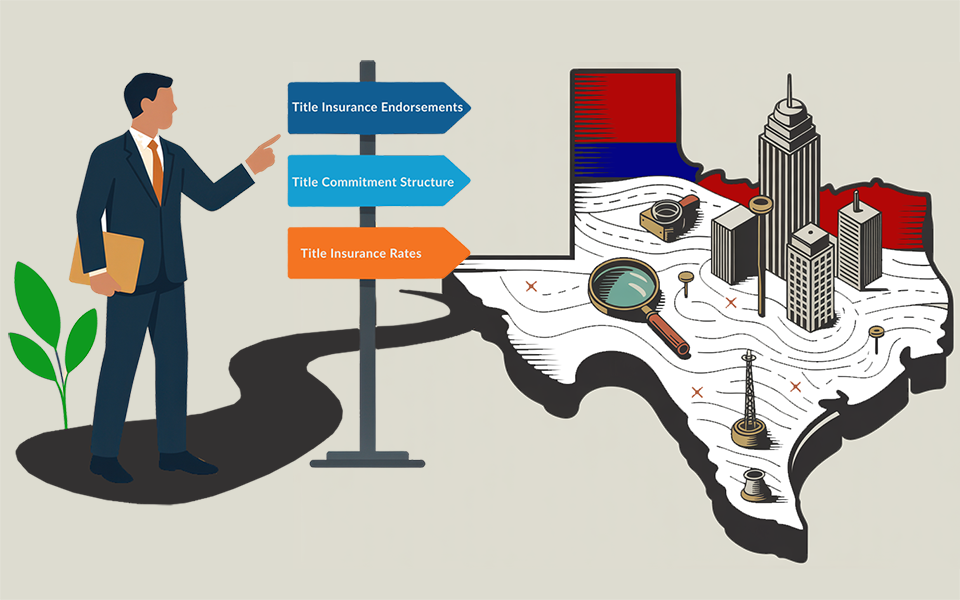December 22, 2025
How Can Large Title Companies Thrive in Volatile Times?

When mortgage rates climbed to 23-year highs in late 2023, one national title insurer watched transaction volume plummet 45% over eight weeks, yet still posted record quarterly profits. Another saw a 35% revenue drop translate into their first annual loss in a decade. The difference? Strategic preparation and disciplined execution during turbulent times.
In today's real estate landscape, market volatility has become the new normal. For large title companies burdened by substantial overhead, public or investor scrutiny, and high client expectations, these fluctuations present both existential threats and unprecedented opportunities. This article provides senior executives with a proven roadmap for transforming market storms into competitive advantages through operational excellence, financial discipline, technological innovation, and strategic positioning.
Understanding the "Storm" and Its Impact
1. Unpredictable Transaction Volumes When mortgage rates dip, refinance activity can surge 60-80% within quarters; when rates rise, purchase transactions may stall by 40% or more. Large title companies must plan staffing, technology capacity, and partner relationships for swings that routinely exceed industry forecasts. Underestimating peaks leads to missed SLA commitments and client defections; overstaffing during lulls means payroll burdens that can eliminate entire quarters of profitability.
2. High Fixed Costs and Scale Disadvantages Unlike smaller agencies that can furlough contract examiners within days, national players maintain dozens of branch offices, regional compliance teams, and enterprise IT systems representing $50-100 million in annual fixed costs. Lease obligations, salaried headcount, and technology licenses remain constant regardless of volume fluctuations—a 30% volume drop can obliterate profit margins without swift action.
3. Intense Stakeholder Pressure Publicly traded title insurers face relentless quarterly earnings expectations, while private equity-backed platforms must demonstrate consistent growth to justify valuations. Boards demand disciplined cost controls but simultaneously expect continued investment in digital transformation and market expansion—a balancing act that requires data-driven decision-making and clear stakeholder communication.
4. Emerging Competition and Consolidation Pressures Tech-focused startups with 40-60% lower cost structures are capturing market share through automated searches, AI-powered risk assessment, and aggressive pricing. Meanwhile, industry consolidation accelerates during downturns: a leading regional insurer acquired three distressed competitors at 0.6x revenue multiples in 2023, instantly gaining 12% regional market share.
5. Elevated Client Expectations Institutional lenders now demand predictive analytics, real-time status portals, and seamless API integrations as baseline service requirements. They expect proactive risk flagging, comprehensive reporting dashboards, and guaranteed SLA performance—all while maintaining competitive fee structures.
Operational Excellence: Converting Market Lulls into Competitive Advantages
Rather than viewing market slowdowns as purely defensive periods, savvy executives use these windows to build operational superiority that compounds during recovery cycles.
Conduct Systematic Workflow Audits Within 30 Days Deploy cross-functional teams to map end-to-end processes from order opening through post-closing recordation. Target identification of 15-20% time reduction opportunities through eliminated handoffs, automated status updates, and streamlined exception handling. Document findings with specific implementation timelines and ROI projections for board presentation.
Implement Scalable Process Automation Deploy robotic process automation (RPA) for high-volume, low-complexity tasks—document generation, fee calculations, and routine correspondence. Leading firms report 25-35% manual workload reduction within six months, enabling experienced staff redeployment to complex problem-solving and client relationship management.
Standardize Best Practices Across All Locations Eliminate procedural variance that creates inefficiencies and compliance risks. Develop uniform checklists, updated procedure manuals, and mandatory training certification programs. Roll out systematically: pilot in 3-5 offices, refine based on feedback, then deploy company-wide within 90 days.
Case Example: During a six-month market contraction, a top-five national insurer revamped commercial closing workflows across 32 offices. When volume returned, average processing time dropped from 18 to 14 days, enabling the firm to win three major institutional contracts previously awarded to competitors.
Financial Resilience: Strategic Resource Allocation During Uncertainty
While cost discipline remains essential, companies that emerge stronger make calculated investments even during downturns—preserving growth capabilities while eliminating operational waste.
Execute Strategic Cost Management Implement tiered cost reduction targeting 15-25% expense reduction within 60 days: eliminate discretionary travel and entertainment, defer non-critical facility upgrades, and renegotiate vendor contracts. Simultaneously, maintain or increase investment in high-ROI digital transformation, client experience platforms, and market expansion initiatives.
Diversify Revenue Streams Aggressively Launch adjacent service offerings within 90 days: property tax monitoring, HOA management, flood certification services, or SaaS licensing of proprietary workflow tools. Target 10-15% revenue diversification within 12 months to reduce dependence on traditional title volume fluctuations.
Pursue Counter-Cyclical Acquisitions Volatile markets create acquisition opportunities at 0.4-0.8x revenue multiples—50% below peak valuations. Establish acquisition criteria focusing on geographic expansion, technology capabilities, or specialized expertise. Complete rigorous due diligence within 45 days and integration planning within 90 days to capitalize on market timing.
Case Example: A publicly traded title insurer acquired a regional technology platform during 2023's market downturn for $12 million—equivalent to 0.6x annual revenue. The acquisition added 400+ clients and proprietary AI search capabilities, contributing $8 million incremental revenue within 18 months.
With operational foundations strengthened and financial flexibility preserved, technology becomes the primary differentiator between market leaders and struggling competitors.
Technology Adoption: The Dual Engine of Efficiency and Market Differentiation
Strategic technology investments during quiet periods generate compound returns when markets recover, creating sustainable competitive advantages that transcend economic cycles.
Deploy Comprehensive E-Closing and RON Infrastructure Implement secure, compliant digital closing platforms within 120 days, targeting 60-80% transaction digitization within 12 months. Integrate remote online notarization (RON) capabilities to serve geographically dispersed clients and accommodate health or travel restrictions affecting traditional closings.
Harness AI for Title Search and Risk Assessment Deploy machine learning algorithms to analyze public records, identify potential liens, and categorize property exceptions with 90%+ accuracy rates. Pilot programs typically achieve 40-50% search time reduction while improving consistency and reducing human error rates.
Implement Predictive Analytics and Business Intelligence Develop forecasting models analyzing transaction patterns, demographic trends, and economic indicators to predict regional demand fluctuations within 10-15% accuracy. Use insights for proactive resource allocation, targeted marketing campaigns, and strategic planning initiatives.
Launch Integrated Client Portal Systems Deploy branded portals enabling real-time order tracking, document access, and automated status notifications. Target 80%+ client adoption within six months, typically reducing service inquiry volume by 30-40% while improving client satisfaction scores.
Building technological capabilities creates the foundation for elevated client relationships that generate premium pricing and long-term loyalty.

Client Engagement: Transforming Transactional Relationships into Strategic Partnerships
Market volatility increases client demand for trusted advisors who provide guidance beyond basic service delivery. Large title companies possess the expertise and resources to fulfill this consultative role.
Deliver Proactive Market Intelligence Launch monthly market analysis newsletters and quarterly webinar series decoding regulatory changes, interest rate impacts, and regional trend analysis. Track engagement metrics and client feedback to refine content strategy and demonstrate thought leadership positioning.
Provide Value-Added Risk Assessment Services Offer scenario-planning sessions analyzing how market shifts affect mortgage payoff schedules, title premium calculations, and escrow funding requirements. Document cost savings and risk mitigation achieved for clients to justify premium pricing and strengthen renewal negotiations.
Develop Customized Reporting and Analytics Dashboards Create tailored performance reports consolidating key metrics: turnaround times, exception resolution rates, cost savings achieved, and comparative market analysis. Quarterly business reviews demonstrating measurable value typically improve client retention rates by 15-25%.
Case Example: A national title insurer launched "Market Resilience Quarterly" webinar series during 2023's market contraction. With 400+ attendee average and 92% satisfaction ratings, the program generated 18 new client relationships and contributed to 95% retention among existing institutional clients.
Technology and client relationships depend fundamentally on workforce capabilities—making talent management a critical success factor during uncertain periods.
Workforce Agility: Preserving Institutional Knowledge While Building Future Capabilities
Experienced underwriters, escrow officers, and examiners represent irreplaceable institutional knowledge. How executives manage talent during downturns directly impacts rebound capacity and long-term competitive positioning.
Implement Cross-Training and Role Rotation Programs When refinance activity drops 50% but purchase volume remains stable, redeploy specialists across product lines within 30 days. Cross-training prevents overstaffing inefficiencies while broadening employee skill sets and improving workforce flexibility for future market cycles.
Deploy Alternatives to Permanent Layoffs Consider temporary measures before permanent headcount reductions: reduced hours (20-30% cost savings), voluntary sabbaticals with partial benefits, or assignment to strategic projects like technology implementation or process improvement initiatives. Preserving institutional knowledge enables 60-80% faster volume recovery when markets rebound.
Invest in Targeted Professional Development Use reduced transaction volume periods to fund industry certifications, advanced training programs, and leadership development initiatives. Employees emerging with enhanced capabilities demonstrate higher productivity and retention rates during subsequent growth cycles.
While internal optimization remains essential, sustained growth requires maintaining offensive market positioning even during challenging periods.
Proactive Business Development: Maintaining Growth Momentum During Market Contractions
Cost discipline without growth focus leads to managed decline. Thriving title companies balance defensive measures with strategic market expansion initiatives.
Amplify Marketing Visibility During Competitor Retreat When competitors reduce marketing spending by 40-60%, maintain or increase brand visibility through virtual event sponsorships, thought leadership content, and social media engagement. Top-of-mind awareness during quiet periods translates into disproportionate opportunity capture during recovery phases.
Strengthen Referral Partnership Networks Schedule systematic relationship meetings with mortgage bankers, real estate brokerages, and legal firms within 90 days. Negotiate preferred-provider agreements and joint-marketing initiatives to secure pipeline commitments for market recovery periods.
Explore Counter-Cyclical Market Verticals When residential volume contracts, pivot resources toward commercial property closings, new construction projects, renewable energy developments, or specialized sectors like 1031 exchanges. Diversification across transaction types reduces single-market dependency and creates new growth platforms.
Case Example: During 2022's residential market slowdown, a regional title company pivoted 30% of resources toward solar farm development closings. This niche focus generated $4.2 million incremental revenue and established relationships leading to $12 million in subsequent commercial development business.
Strategic Partnerships and Flexible Capacity Management
Even the largest title companies benefit from converting fixed costs into variable expenses through strategic partnerships that provide scalability without capital commitment.
Leverage Third-Party Search and Reporting Services Outsource labor-intensive tasks—municipal lien searches, HOA estoppels, and payoff coordination—to specialized vendors on transaction-based pricing. This approach reduces fixed labor costs by 25-40% while maintaining service quality and delivery timelines.
Establish Technology Integration Partnerships Deploy best-of-breed solutions through API partnerships rather than internal development: fraud prevention systems, AI document review, or specialized compliance platforms. Partnership strategies accelerate capability deployment while sharing development costs and technical risks.
Develop Joint Venture Opportunities Consider co-branded service offerings or white-label technology licensing arrangements with complementary service providers. Collaborative ventures enable market expansion without full capital investment while creating additional revenue streams.
Established service providers like Skyline Title Support have demonstrated the value of flexible capacity partnerships, enabling large insurers to maintain service quality during peak periods while avoiding fixed cost burdens during contractions.
Conclusion: From Survival to Market Leadership
The next market storm isn't a question of "if" but "when"—and preparation separates industry leaders from casualties. Companies implementing these strategies don't merely survive volatility; they emerge with expanded market share, enhanced capabilities, and stronger competitive positioning.
The most successful title companies view market downturns as strategic accelerators: opportunities to optimize operations, acquire capabilities at favorable valuations, strengthen client relationships, and build technological advantages that compound during recovery cycles. While competitors focus on defensive cost-cutting, market leaders balance discipline with calculated investment in future growth.
The choice facing every senior executive is clear: Will your company be among the few that transform the next market storm into sustainable competitive advantage? The strategies outlined here provide the blueprint—execution will determine the outcome.
Start today. The next opportunity to build market-leading capabilities during advantageous conditions may be closer than you think.
Related Posts
2026 Title Industry Outlook: Top 10 Trends That Will Redefine Due Diligence and Closings
The title industry is heading into 2026 with more moving parts than at any time in recent memory: rapid regulatory change, deeper fraud risk ...
December 22, 2025
Beyond the Basics: Navigating Title Complexity in Texas Commercial Real Estate
Last spring, a Dallas investor was three days from closing on a mixed-use development site when the title examiner discovered something unusual ...
December 22, 2025
Witchy Titles & Cursed Closings: What Salem’s History Can Teach Us About Real Estate Due Diligence
In 1692, the town of Salem, Massachusetts descended into chaos. Fueled by fear, rumors, and suspicion, dozens of people were accused of witchcraft and ...
December 22, 2025
Title Under Siege: A First Look at Our New Guide to Deed Fraud and Seller Impersonation
Seller impersonation, in particular, is on the rise. In these cases, a scammer poses as the property owner—usually targeting vacant land, rental...
December 22, 2025
Real Estate Due Diligence Checklist: 9 Hidden Costs That Kill Closings
Imagine this: A $3.2 million Miami Beach home sale implodes because of a $127 unpaid utility lien that no one caught in time. Absurd as it sounds ...
December 22, 2025
Mastering UCC Searches: A Comprehensive Guide for Title Professionals and Lenders
In the world of commercial real estate and lending, due diligence is everything. Whether you're a title agent preparing for a closing in New York ...
December 22, 2025
Land Surveys vs. Title Searches: When You Need Both (and How to Budget)
Picture this: you’re days away from closing on a home when an unexpected hiccup surfaces. The seller’s old fence sits two feet inside the neighbor’s...
December 22, 2025
Top 10 Municipal Red Flags That Can Delay Your Closing (and How to Fix Them)
Real-estate contracts are filled with dates, deposits, and delivery deadlines. Yet even when buyers, sellers, and lenders stay on schedule ...
December 22, 2025
A Complete Guide to HOA Estoppel Letters: Everything Title Professionals Need to Know
Picture this: You're three days from closing, and suddenly you discover the HOA has outstanding fees that nobody knew about. The seller is scrambling ...
December 22, 2025
Summer Real Estate: Keep Closings Cool When the Market Heats Up
Summer signals one of the busiest times in real estate, especially in Florida, as well as in fast-growing markets like Texas, Arizona, and ...
December 22, 2025
Navigating Florida’s Title Regulations for Small Title Agencies
Running a small to mid-sized title agency in Florida can feel like juggling flaming torches—there’s licensing, escrow accounting, audits, data security ...
December 22, 2025
Top Mistakes When Ordering a UCC Search
UCC Searches are crucial in risk assessment and due diligence in commercial lending and secured transactions. Yet despite their importance, we have ...
December 22, 2025
The Role of Deed Preparations in Real Estate Transactions
In the high-stakes world of real estate, certain documents tend to get all the attention—purchase agreements, title insurance, and mortgage ...
December 22, 2025
The Title Pro's AI Companion: Using Skyline's SmartTitle Assistant
How much time did you spend drafting repetitive client emails today? Our average title professional saves 5+ hours weekly using SmartTitle Assistant™ ...
December 22, 2025
UCC Search vs. Title Search: What's the Difference — and Do You Need Both?
In the complex world of real estate transactions, due diligence is everything. Whether you're a lender evaluating a loan application, an investor ...
December 22, 2025
The Hidden Headaches of Association Estoppels in FL — And How to Avoid Them
Few documents cause as many unexpected delays and frustrations in the complex world of Florida real estate transactions as association estoppels ...
December 22, 2025
Navigating Market Volatility: What Title Professionals Need to Know Now — and What's Ahead in 2025
In today's real estate landscape, the only constant is change. Fluctuating interest rates, economic uncertainty, and shifting regulatory policies have ...
December 22, 2025
What Happens if a Satisfaction of Mortgage is Not Properly Recorded?
Paying off a mortgage is a significant financial milestone, but the process isn’t complete until the lender records the mortgage satisfaction with the ...
December 22, 2025
Generating New Business for Title Companies in a Competitive Market
The title industry is transforming. Increased competition, technological advancements, and shifting consumer expectations are challenging traditional ...
December 22, 2025
Spring Cleaning for Your Property Title: How to Refresh Your Real Estate Records
Millions of real estate transactions are delayed or fall apart each year due to title issues that could have been prevented. In fact, a recent study ...
December 22, 2025
Top Strategies to Prevent Quiet Title Issues
Quiet title disputes are a serious concern for real estate professionals, as they can disrupt transactions and create uncertainty around property ownership ...
December 22, 2025
Title Services for New Construction: What Builders and Developers Need to Know
The construction of a new home or commercial property is an exciting and ambitious project, but it comes with more than just design and building ...
December 22, 2025
Will AI Agents Replace Title Professionals? The Truth About Automation
Artificial intelligence (AI) has evolved beyond simple data analytics and chatbots. Today's AI "agents" can interact with web browsers, gather and analyze ...
December 22, 2025
10 Reasons Why Skipping a Land Survey Can Be Costly
A land survey might seem like an unnecessary expense, especially if the property has been owned for years without any issues. However, skipping this step ...
December 22, 2025
Title Industry 2.0: Harnessing AI, Data, and Cybersecurity for a Resilient Future
The title industry is at a crossroads. Traditional methods that have served us well for decades now face mounting challenges in an increasingly ...
December 22, 2025
How Title Services Impact Mortgage Underwriting Timelines
In the world of real estate, the journey from application to closing is filled with numerous moving parts. Among these, title services are a crucial yet ...
December 22, 2025
How Title Companies Can Meet Tight Deadlines Without Sacrificing Quality
In today's fast-paced real estate environment, speed is crucial. Title companies often find themselves in high-pressure situations where they must juggle ...
December 22, 2025
5 New Year's Resolutions for Title Companies in 2025
As 2025 kicks off, the title industry is moving faster than ever. With new technologies, shifting customer needs, and more complex regulations, there’s ...
December 22, 2025
How to Explain Title Insurance to Your Clients: A Real Estate Agent's Guide
Explaining title insurance isn't always straightforward, but with the right approach, it can become a valuable teaching moment for your clients. Picture this ..
December 22, 2025
The Hidden Complexities of Property Title Searches
You've found your dream home. The price is right, the location is perfect, and you're ready to sign on the dotted line. But before you do ...
December 22, 2025
5 Common Problems Found in Municipal Lien Searches and How to Resolve Them
Municipal lien searches are a crucial part of any real estate transaction. They uncover hidden financial and legal obligations tied to a property, ensuring ...
December 22, 2025
What’s Next for the Title Industry? Key Trends for 2025
The title industry is at a pivotal moment, with 2025 shaping up to be a year of significant transformation. From groundbreaking technologies like blockchain ...
December 22, 2025
Commercial Property Title Due Diligence: Going Beyond the Basics
The landscape of commercial property title due diligence has transformed dramatically over the past three decades. Gone are the days when a basic title ...
December 22, 2025
Beyond the Standard Search: Advanced Commercial Title Due Diligence in Florida
Last month in South Florida, a seasoned commercial real estate investor nearly walked away from a $12 million mixed-use development purchase ...
December 22, 2025
Navigating the Cyber Minefield: A Title Professional's Complete Guide to Phishing Defense
The title industry is a prime target for cybercriminals, and phishing is one of the most common threats that title professionals face today. Imagine this ...
December 22, 2025
Elevating Your Title Company to New Heights - A Blueprint for Growth
Let's be honest – growing a title company isn't what it used to be. Gone are the days when simply maintaining the status quo was enough to ...
December 22, 2025
This Halloween Avoid Real Estate Nightmares: 5 Spooky Title Issues That Can Haunt You
Buying a new home is exciting, but not all surprises are welcome. Some title issues can be like ghostly figures lurking in the shadows ...
December 22, 2025
How to Overcome Common Title Operations Challenges and Boost Efficiency
Running a title company means you’re a key player in the real estate world, making sure property transactions go smoothly and securely. But, we get it ....
December 22, 2025
🎙️QuickCast: Future Trends in the Title Industry.
The title industry, like many others, is undergoing significant transformation due to technological advancements. While some of these changes ...
December 22, 2025
Zoning Letters and Everything You Need to Know About Them
A Zoning Verification Letter is an essential document that a property owner or developer may need to request from the local municipality....
December 22, 2025
Understanding Municipal Lien Searches: A Complete Guide
Imagine this scenario: You've discovered an incredible property, yet as the closing date approaches, an unsettling surprise reveals itself—a municipal lien...
December 22, 2025
Wire Fraud : Proven Defense Tactics for Title Professionals
Wire fraud is a rapidly growing threat in the real estate industry, with fraudsters becoming more sophisticated and aggressive in their ...
December 22, 2025
Preparing for August 17th: Essential Information on the NAR Broker Commission Changes
The real estate market is about to undergo significant changes as new commission regulations take effect on August 17. These changes ...
December 22, 2025
Maximize Efficiency in Your Title Business with AI
Integrating AI into title businesses can significantly enhance efficiency, accuracy, and customer service. By automating routine tasks, improving...
December 22, 2025
The Importance of Land Surveys in Property Transactions: What You Need to Know
Boundary surveys are essential in property transactions to accurately define property lines, identify encroachments, and resolve disputes. Conducted ...
December 22, 2025
Summer Selling Season: Essential Steps for Real Estate Pros to Ensure Smooth Transactions
Essential steps for real estate professionals to ensure smooth transactions during the bustling summer selling season include preparing properties, ...
December 22, 2025
A Step-by-Step Guide to Conducting a Thorough Municipal Lien Search
A thorough municipal lien search is crucial for uncovering any financial or legal claims against a property. This step-by-step guide ....
December 22, 2025
10 Interesting Facts About Colonial Land Ownership
Colonial America’s land ownership shaped the U.S. under British rule. Exploring these practices reveals the era’s struggles and innovations in property rights.
December 22, 2025
How Tax Certificate Searches Can Save You Time and Money in the Loan Closing Process
Tax certificate searches streamline loan closings, mitigate financial risks, ensure tax compliance, and save time and money for real estate professionals.
December 22, 2025
Recent Posts



























































